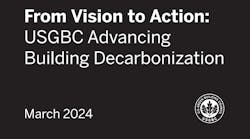PRESS RELEASE
March 2024 — At USGBC, we are bringing all our tools and resources to meet this challenge. Our newly released 2024–2026 strategic plan underscores the priority we are placing on climate action—and our leveraging of our unique role to make change happen.
USGBC brings together diverse decision makers in the buildings industry: an array of public and private entities including architects and engineers, building developers, owners, tenants, operators, product manufacturers, and professionals in the finance and insurance, retail, hospitality and government sectors at all levels. The common thread is a motivation to do better.
- Download the new report here.
Our strategic plan leads to the ultimate objective of market transformation at scale, through effective programs built on proven strategies that will enable a much broader swath of the building industry and related sectors to take immediate steps toward their goals. We are excited to share this report on what we’re doing to make change happen.
INTRODUCTION
Scientists have spelled out the global climate challenge loud and clear: We must cut our global carbon emissions by at least 50% by 2030 to stave off the worst impacts of global warming. As signs of climate change are increasingly evident around the globe, it is impossible to ignore—and governments and corporations are committing to reducing emissions.
Decarbonization has become a shorthand term for removing the production of greenhouse gases, predominantly carbon dioxide, from the global economy. Buildings are a critical sector to address—and after decades of advocacy by the U.S. Green Building Council (USGBC) and others, buildings are now recognized for being both a climate problem and a solution. Indeed, buildings comprise about one-third of global energy-based emissions; that proportion grows when you include construction, materials and emissions related to water and waste.
With developments in building science and technology, new buildings are now much more efficient than they were 30 years ago. Every day, we see more net zero energy and low-carbon
buildings. With global demand for building space still growing to meet populations, though, building sector emissions could go in the wrong direction and grow, rather than coming down to meet its share of climate needs.
In this context, the Buildings Breakthrough was launched at COP 28 to collaborate in moving toward the vision of worldwide near-zero-emission and resilient buildings. This resonates with USGBC, as we have been working for our entire 30-year history to show how partnership and collaboration can work to support shared climate, health and resilience goals.
- To listen to HPAC's recent podcast on COP28 with USGBC's Liz Beardsley, click here.
The question today is: How do we scale and ensure rapid adoption of proven practices to reduce buildings’ whole life carbon impact?
At USGBC, we are bringing all our tools and resources to meet this challenge. Our newly released 2024–2026 strategic plan underscores the priority we are placing on climate action—and our leveraging of our unique role to make change happen. USGBC brings together diverse decision makers in the buildings industry: an array of public and private entities including architects and engineers, building developers, owners, tenants, operators, product manufacturers, and professionals in the finance and insurance, retail, hospitality and government sectors at all levels. The common thread is a motivation to do better.
Our strategic plan leads to the ultimate objective of market transformation at scale through effective programs built on proven strategies that will enable a much broader swath of the building industry and related sectors to take immediate steps toward their goals. We are excited to share this report on what we’re doing to make change happen.
To read the report and access USGBC's library of resources, click here.
##########










